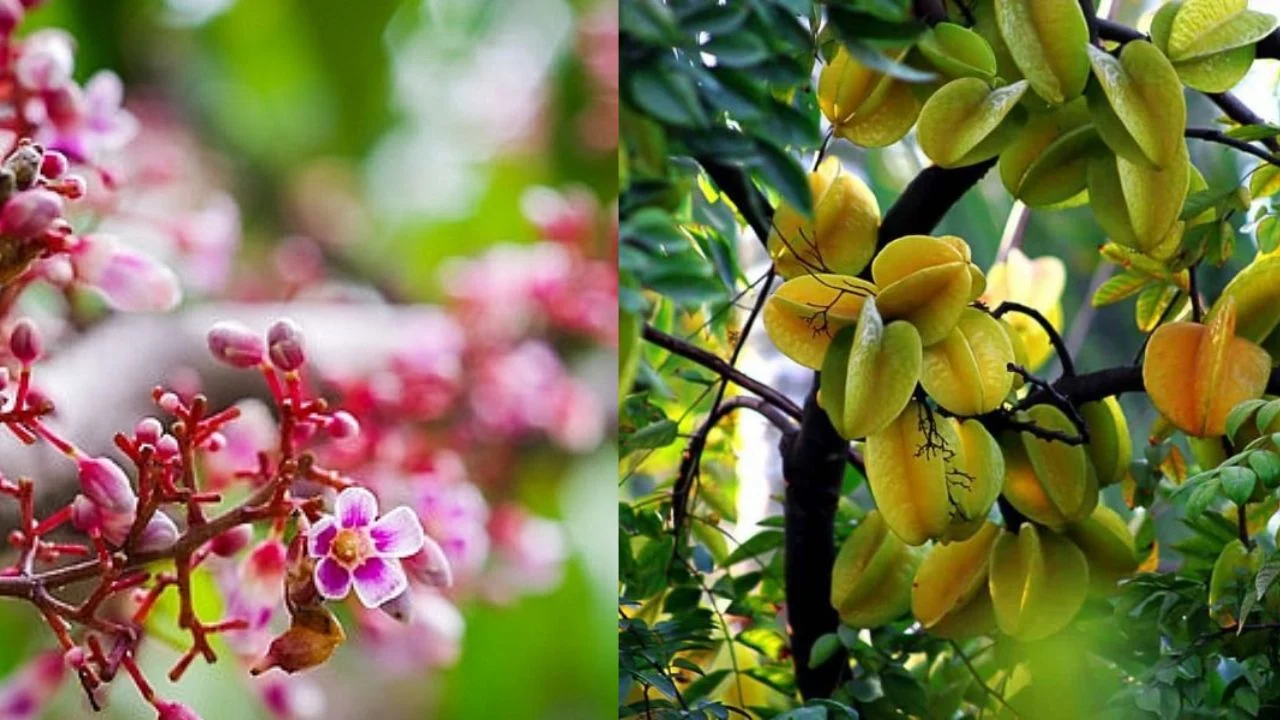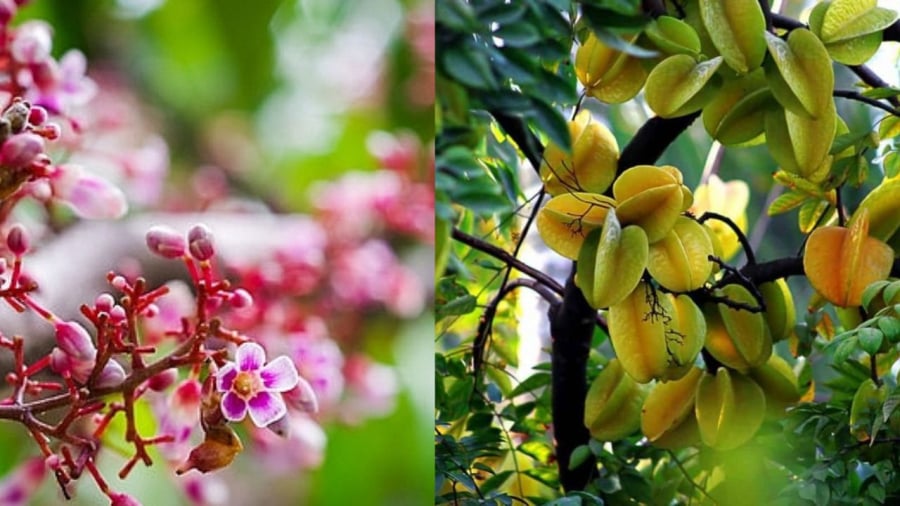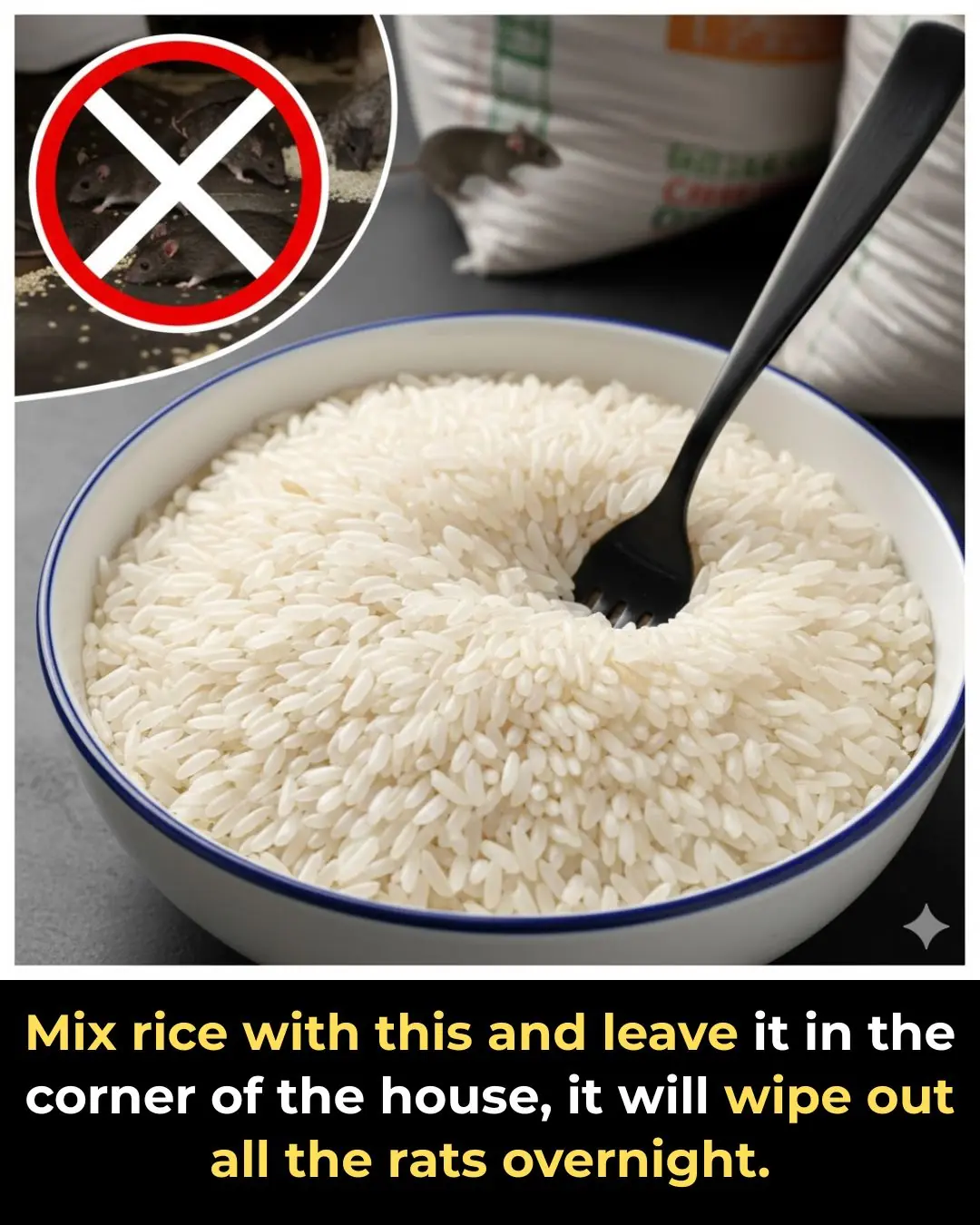
Good tips for those who have dry trees, help them produce many flowers, fruits, and sweet and rich fruits

**Why Do Many Homegrown Starfruit Trees Produce Bland or Unsweet Fruit?
Tips to Grow Sweet, Healthy Starfruit at Home**
Growing starfruit trees at home has become a popular hobby for many families. Some people grow them directly in their garden, while others plant them in pots or train them into bonsai shapes as a beautiful and symbolic ornamental plant. A starfruit tree in full bloom produces dreamy clusters of purple flowers in autumn, and its golden, drooping fruit brings charm and good fortune. Even the leaves and fruits have various health benefits.
However, many homeowners face frustrating problems: the tree does not flower, fruits drop prematurely, fruits turn mushy, or most commonly—the fruit is bland and not sweet. Fortunately, with the right techniques, you can grow a starfruit tree that is both ornamental and produces delicious fruit.
1. Watering: One of the Most Important Factors
Starfruit trees prefer consistently moist soil, especially when grown in pots.
-
During the first months after planting, water every two days, ensuring the soil stays moist but not waterlogged.
-
After about three months, gradually reduce the frequency, depending on the weather and soil condition.
-
Young potted trees need extra attention—if the soil dries out, the tree becomes stressed and may drop flowers and fruit.
Pro tip: During the fruit-bearing stage, the tree needs even more moisture. Watering twice a day—early morning and late evening—helps prevent fruit from falling prematurely.
2. Pruning to Shape and Strengthen the Tree
Proper pruning helps the tree grow strong branches, receive enough sunlight, and stay free from pests.
-
The best time to prune is right before flowering and after harvest.
-
Starfruit trunks can crack if exposed to direct, harsh sunlight, so shaping the canopy helps protect the trunk.
-
Remove old, weak, diseased branches and any that grow densely and block airflow.
-
For larger trees, thin out crowded canopies to ensure light reaches the inner branches.
Well-pruned trees produce more buds, more flowers, and ultimately—more sweet fruit.
3. Fertilizing Correctly for Sweet Fruit
A starfruit tree cannot produce sweet fruit if it lacks nutrients.
-
Organic fertilizer is ideal because it enriches the soil without damaging it.
-
In the past, people buried small dead animals such as chickens or fish at the base of the tree to nourish it naturally.
-
Today, you can replace this with NPK fertilizer, potassium during the fruiting stage, wood ash, or limestone powder to enhance sweetness.
Additional tip: Feeding the tree fermented organic matter or liquid compost boosts nutrient absorption and makes the soil more fertile.
4. Pest and Disease Control
Starfruit trees are prone to certain pests:
-
Leaf-eating caterpillars
-
Fruit flies
-
Wasps that sting and damage developing fruit
Use Trebon 0.2% during early fruit development (avoid spraying when fruit is large to prevent toxicity).
During the dry season, coat the trunk with limewater to prevent bark-boring insects from attacking.
When the tree is fruiting, keep an eye out for wasps and remove their nests or scare them away to protect the crop.
5. Techniques to Improve Flowering and Fruit Quality
To ensure your tree produces abundant fruit:
✔ Encourage new shoots
Cut off about 20 cm of the soft tips of developing branches. This stimulates new buds and tiny flower clusters to form in leaf axils.
✔ Control excessive growth
If the tree grows too tall and becomes difficult to manage, bend or prune only the thicker low branches first, leaving the smaller ones for later.
✔ Starve the tree briefly to trigger flowering
Stop watering for 2–3 days, then feed the plant with a very diluted urea solution. About 50 days later, the tree will flower more vigorously.
✔ Maintain soil fertility
-
Add well-rotted organic compost around the base twice a year.
-
Apply bat guano every two months for strong growth.
-
Water the tree with rice-rinsing water once a week to improve soil nutrients naturally.
These methods help the tree form more flower buds and grow sweeter, larger fruit.
Conclusion
Growing a starfruit tree that produces sweet, abundant fruit is completely achievable when you understand its needs. With proper watering, pruning, fertilizing, and pest control, your tree will not only beautify your home but also reward you with baskets of delicious golden starfruit.
News in the same category


Pour salt into the toilet, everyone calls you crazy but know its uses and do it at home right away

Amazing uses of pouring vinegar on meat: Everyone who knows will want to do it too

Chef reveals secret to stir-frying soft, lump-free vermicelli noodles that even the most clumsy person can easily do

Do not throw away air conditioner wastewater, it has many useful uses that many people do not know.

A Simple Sock Trick to Clean Dusty Window Blinds with Almost Zero Effort

Mix rice with this and leave it in the corner of the house, it will wipe out all the rats overnight.

When choosing a cantaloupe, use these 4 tips to ensure you buy one with thin skin and sweet flesh.

Air Conditioner Blowing Only Air but Not Cooling? Here’s How to Fix It Without Calling a Technician

Had no clue about this

Why Does Your Refrigerator Frost Over and Does It Increase Electricity Consumption?

How to Grow Potatoes Easily from Sprouted Tubers and Enjoy Them All Year Round

You are doing it all wrong. Here’s the right way to ease morning stiffness

You are doing it all wrong. Here’s the right way to clear sinus pressure fast

Doctors Warn: 4 Types of Inflammation That Can Turn Into Cancer Within a Year If Left Untreated

**Garlic Skins Are Not Trash — Don’t Throw Them Away Yet!

There are too many geckos in the house, give you some tips to make them 'once gone and never come back'

When cleaning the house, add this to the water and the floor will be as clean as new

How to boil chicken until it's soft and sweet
News Post

THIS SEED: AFTER 50, IT STRENGTHENS BONES & CURES ALL PAINS

High Blood Pressure Has a New Culprit

Civil War Era Politician Robert Smalls Becomes First African American to Receive Monument in South Carolina

How to treat nerve pain in the foot, toes & legs

Dr. Patricia Bath Set To Make History As First Black Woman Inducted Into National Inventors Hall of Fame

Unlocking the Power of Rosemary Tea: A Natural Elixir for Mind, Body, and Soul

🌌 An Accidental Revolution: How the Search for Black Holes Led to the Invention of Wi-Fi

📈 The $5 Trillion Threshold: NVIDIA Becomes the World’s Most Valuable Company, Reshaping Global Economic Influence

Angela Davis to Keynote Largest Black Feminist Conference in the Nation

🐝 The Silent Threat: Research Links Cell Tower Radiation to Harmful Effects on Honey Bee Health

NYC-Based Events Company Is Creating Spaces to Empower Indy Black Artists Across the East Coast

Why Some Eggs Are Speckled

Drinking Water the Right Way

This is the correct way to preserve pork in the freezer: The meat will not dry out, and will still retain all its nutrients for a whole month.

Pour salt into the toilet, everyone calls you crazy but know its uses and do it at home right away

What Are the “Black Triangles” Between Your Teeth

Inserting a toothpick into this exact spot on the electric kettle has an amazing effect — a useful trick everyone should know

Amazing uses of pouring vinegar on meat: Everyone who knows will want to do it too

Chef reveals secret to stir-frying soft, lump-free vermicelli noodles that even the most clumsy person can easily do
